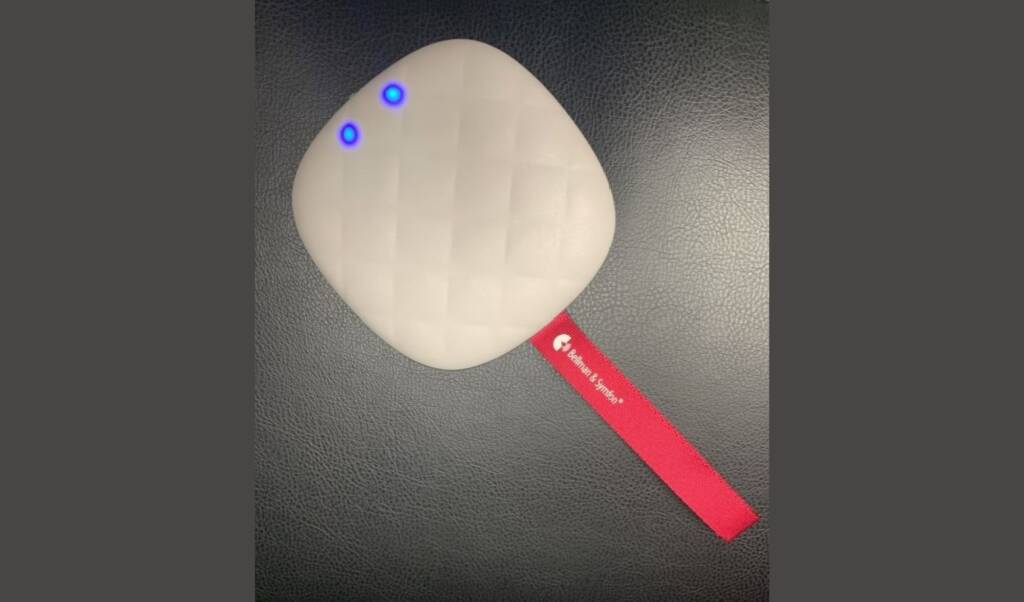Getting a Good Vibe From The Vibio Bluetooth Bed Shaker From Bellman & Symfon
Read this review of the Vibio Bluetooth Bed Shaker which discusses the app, its notifications, the alarm settings, the product's vibrations, and more.

By Scott Davert, Coordinator: Technology, Research and Innovation Center, Helen Keller National Center for DeafBlind Youths and Adults
September 13, 2023
Introduction
Not long ago, I started finding that the TCL Pulse, a product which I have been using for several years, was no longer waking me reliably. While solutions like the Apple watch can support the waking of a DeafBlind person, and the process of setting that alarm is accessible technologically speaking, the price for an Apple Watch may not be acceptable to many, especially if being able to complete such a task is your only interest. The other thing I have noticed is that the vibration motor in my phone has not been strong enough to sufficiently alert me to new texts, a problem I didn’t think would be solvable with this product.
Description
The Vibio is a small device that is shaped like a square with rounded corners. It measures 3.7 inches wide by 3.7 inches long and has a depth of 1.06 inches. With the Snooze Strap being the closest thing to you, the physical lay-out is as follows. On the bottom edge, you will find the aforementioned snooze strap. Moving up the left side of the device, you will find a Micro USB port for charging. On the top edge, furthest to the right, is a Reset button followed by an on/off switch to the left of it. Note, when the switch is slid so that it is closest to the Reset button, Vibio is turned off. On the back side of the device, you will find a sticker which gives you the serial number and other product information.
The Vibio is a device designed not only for setting alarms, but also getting notifications of both text messages and phone calls. My testing found that the product is compatible with iOS 16.6.1, iOS 17 and Android 13, though the manual states that it is compatible with all operating systems on Android and iOS going back to 4.x. An iPhone SE 3, iPad Pro, iPhone 14 Pro Max and Pixel 7 were used to conduct this evaluation.
Setting It Up
After downloading and installing the app from the iOS App Store or the Android app from the Google Play store, I first selected the Add New Vibio button. Both apps walk the user entirely through the set-up process. The only part of the set up that did present a small challenge was knowing for sure that I have successfully put the Vibio in pairing mode. While a sighted user can verify this through lights, having a brief vibration to notify the user that they have put the Vibio into pairing mode would address the issue of assuring someone without hearing or vision can know when the device is ready for pairing. That said, I pulled the snooze strap 2 times and held it briefly before releasing and I did get confirmation in the form of my phone finding the device. There will be requests from the app to access certain things on iOS and Android, with a larger number being found when setting up a Vibio on Android. Each request also provides information from the app specifically, which is a nice touch, as users are informed what the app needs the permission for. Once all permissions have been denied or granted, you will then be taken to the app’s main screen.
The App
When you launch the app with Vibio connected you will first encounter a menu at the top left corner. In this menu, you will find options for settings, purchasing Vibio, help, a link to the Bellman & Symfon website as well as a link to their Facebook page.
After going into the settings, you will encounter options to control the snooze interval and whether you are alerted to phone calls, text or neither. It is also possible to control the vibration strength of the Vibio. The options are Soft, Medium and Strong. I prefer the soft vibration when the Vibio is in my pocket, and the Strong vibration for either when put under a pillow or mattress.
Returning to the opening screen, the next item you will encounter is the battery status. During my initial testing, the battery status did not change other than to indicate whether the Vibio was charging or not. The only way I knew whether the battery was dying was when it quit working. This was duplicated on 2 iPhones as well as on a Pixel 7. That said, charging the Vibio weekly should be more than sufficient, as I typically was getting at least 10 days between charges. Your mileage beyond a week may vary based on the number of times you are alerted, and the strength of the vibration set. Disconnecting the Vibio from your phone at night may also prolong battery life, or turning off the Vibio itself may help as long as you do not have an alarm set.
When I notified Bellman & Symfon of this issue, they sent me a Vibio that was able to display the battery status correctly. It was a prompt replacement, and I have had no issues with the product since that time. The company made sure that it was resolved in a timely manner.
One other suggestion I have regarding the charging itself would be to provide a vibratory notification when the charger is connected and disconnected. Again, if there is a notification being conveyed visually, which there is, it would be great to make this feature equally inclusive for those with and without vision.
The next thing you will find on the app indicates the Vibio’s connection status. I’ve found this fully accessible as well with both VoiceOver and Talkback and braille and that it is consistently correct.
After the “welcome” heading, you will find the option to add an alarm.
Managing Alarms
Setting the alarm is fully accessible on iOS as a braille or VoiceOver user and is fully accessible on Android using TalkBack. However, for a braille display user, it is only accessible with quite a few workarounds on Android assuming your braille display is supported by Android. When setting the alarm, there are several sliders that one needs to interact with. These include setting the time for the alarm and also configuring whether you would like the alarm to go off on specific days. These sliders are fully accessible using iOS with VoiceOver and/or braille, but only for those who can hear the speech on Android. Though the sliders are adjustable using TalkBack’s swipe up or down with 2 fingers gestures, there is no braille display keyboard equivalent. A braille user must take a hand off the braille display to manipulate the touchscreen. As the various sliders are being adjusted, there is no immediate braille feedback that this change has occurred. It is only readable in braille after navigating away from that slider and then coming back to it. These are challenges facing braille users on Android overall, but this is how they exhibit themselves in the Vibio app. I’ve encountered this issue in many Android apps, and it is my opinion that Google would need to address this issue before the product can be fully accessible to a braille user. The good news for Bellman & Symfon is that it has been my experience that most braille users tend to gravitate toward iOS. This is because it has a much more robust feature set and it also supports a wider array of devices than Android, especially where Bluetooth is concerned.
After configuring the alarm, saving it is also accessible as described above. When you have saved your changes, Vibio will vibrate once to confirm. Again, this nonvisual confirmation is helpful in the same way the lights are helpful for those who can see them.
There are also options to edit an already set alarm and to turn the existing alarm on or off. There is only one alarm listed on each page, so the user must scroll left or right to move among the alarms. You can configure up to 10 alarms.
Now For The Alarming Part
The alarm has worked for me almost 100% of the time I have used it. The only time it failed to go off was when the battery was dead on the defective Vibio. It continues to be reliable and, since I am now able to know the status of the battery, I know exactly when to charge it.
When the alarm goes off, you can disable it in the app, or by pulling the Snooze Strap twice. Pulling it once will snooze the alarm for the amount of time you specified in the settings of the Vibio app. If you put Vibio under a pillow or mattress, it is important to leave the Snooze Strap dangling in a place where you can get to it. Alternatively, you will need to keep your connected device nearby to deactivate the alarm.
Text And Phone Call Notifications, Including The iPad!
As noted in the introduction, Vibio also alerts the user to both incoming phone calls and text messages. I’ve not only found this to be reliable on my iPhone and Android phone, but also on the iPad. This means that a DeafBlind person using an iPad finally has a way to get alerts for new text messages and FaceTime calls through vibrations. This was an issue in the past, since the iPad does not have a vibration motor. For me personally, I leave the vibration strength set to Soft while it is in my pocket. The vibration set to this level allows me to detect text notifications and the vibration is less noisy. One of the nicest things about Vibio is that it also respects your Do Not Disturb settings, so if you put it under a mattress or in a pillow, you will not be notified of new texts unless your connected device is set to allow these notifications. While testing, I was able to also receive alerts for calls from T-Mobile IP Relay and Facebook Messenger. Note that in the case of Facebook Messenger, only calls seem to work.
Conclusion
The Vibio is a solid device which has proven to be a reliable addition to the tech in my life. It has a much stronger vibration than the product I was using previously, and also alerts me to incoming texts. Further, the Snooze Strap is very helpful since I just pull on it to snooze alarms instead of fumbling for a button that may not be easy to locate such as what was provided on the previous product I was using. The Vibio, much like my iPhone, has become an essential tool to waking up and keeping me connected with confidence.
For more product information or to purchase, please see Vibio’s Product Page. The cost for the Vibio in the United States is $119.95, though at the time of writing, was on sale for $79.95.


